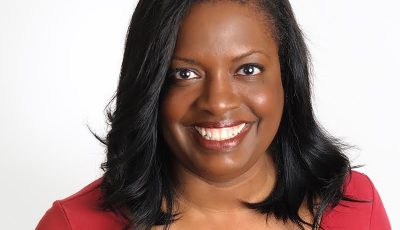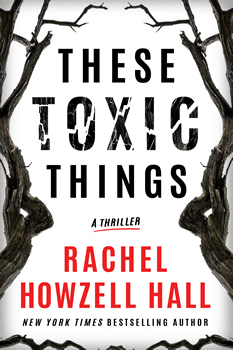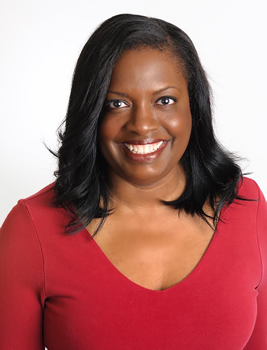

On the Cover: Rachel Howzell Hall
A Thrilling Coming of Age Mystery
 By Dawn Ius
By Dawn Ius
Curiosity shops have long been woven into the fabric of pop culture—brimming with historic artifacts and unusual trinkets, these often-quirky stores provide storytellers the perfect setting for mystery and mayhem. After all, who can forget Stephen King’s Needful Things?
With her latest standalone novel, bestselling author Rachel Howzell Hall joins a growing list of writers who have mined story gold from a curiosity shop, an idea she says was born during quarantine when, like so many others, she found herself spending a lot of time looking at pictures and reminiscing.
But as Howzell Hall says, some of those memories have been newly “shaped, shaved, and shorn” because of COVID-19.
For digital archaeologist Micaela “Mickie” Lambert, archiving those memories—as close to authentically as possible—is one of the most important aspects of her company, Memory Bank. So when she’s called to an eclectic curiosity shop in seedy Santa Barbara, California, to help the owner, Nadia, digitize her inventory, Mickie looks forward to helping create a robust scrapbook of souvenirs, pictures, and memories. Mickie soon realizes that it won’t be an easy job—Nadia is suffering the early stages of Alzheimer’s. Still, the two hit it off, and their work is to begin the next day.
But when Mickie arrives at These Beautiful Things later that evening, Nadia is dead—a suspected suicide. With the check already cashed, Mickie decides to proceed with the project.
Meanwhile, a serial killer is on the loose, Mickie is convinced she’s being followed, and the more she digs into the past—both Nadia’s and her mother’s—the more disturbing revelations are uncovered.
THESE TOXIC THINGS is textbook Howzell Hall, with a tightly woven plot, original characters, and enough twists and turns to keep you powering through to the end. In this interview with The Big Thrill, Howzell Hall takes us deeper into the inspiration for this gripping standalone and gives us a peek into her personal collections.
The premise of THESE TOXIC THINGS is delicious. The past two years, with quarantine, have really created an opportunity for us to get to know those closest to us—for better or worse. I’d love to know what inspired this book.
Thank you! A lot of this novel comes from being quarantined and deciding to do “projects”’ like cleaning out closets and junk drawers, acquiring new things to make our space new. A lot of us spent a lot of time looking at pictures of the past—parties, graduations, weddings—and reminiscing. In times of trouble, we romanticize these moments because we were all together, often forgetting about the fights, the slights, the passive-aggressive behavior. Our memory has warped because we haven’t spent as much time with family and friends—and we’re all re-telling stories that have been newly shaped, shaved, and shorn because of COVID-19.
Like everyone, I was in this space, going through closets and remembering—and misremembering. And the older I get, the older my parents get, the more stories have come out, and like many people, these stories raise eyebrows. Some of these stories eat away at you. Some of these memories eat away at you. Some of the tchotchkes we rediscover eat away… Sometimes, these things are… toxic.
I love that Mickie is a digital scrapbooker—no storage room full of paper swatches and stickers for her! Have you known a scrapbooker or have you been one yourself? What about scrapbooking made this the perfect job for Mickie?
I’m not a formal scrapbooker, but I do keep memorabilia. I have, for example, the first story I wrote. As a kid, I made a Duran Duran scrapbook because I was a huge fan. I’ve kept my daughter’s baby teeth and different-colored swim caps from her lessons. I have her baby book, and if someone were to flip through the pages, they’d see me as a happy pregnant woman in her Gap Maternity wear… and they’d have no idea that I had been battling breast cancer while smiling for those pictures. So while scrapbooking and keeping mementos capture a moment of time, they don’t paint a complete picture. I thought about this as I wrote, and now that everything’s digitized, I find myself sending these digital photos to companies that will print them out or make physical albums. In other words, I’m resorting back to analog.
On the other hand, you have young people who rely on the digital realm to live—and now, with Siri and Alexa, they have digital “Moms” in a way, to tell them how to live, what to buy… and now, what to remember. We all receive those messages and pictures on our phone or social media about what we did last year this time. And that’s Mickie’s job: helping people select those memories worth uploading to a device.
I’m always grateful when I stumble across a great curio shop—they’re certainly not as abundant as they once were, at least not that I’ve found. Was These Beautiful Things based on a shop you have been to/know of?
As an adult, I didn’t visit many curio shops before writing this story except while on vacation. As a kid, though, I’d go with my mom to these rummage stores and look mostly for designer clothes. I found a pair of green Chemin de Fer (hahaha) jeans in a rummage store.
My husband collects far too many things—coins, hockey cards, signed pictures from his favorite sports teams—while my collection tendencies are a bit less extreme. If we went through your most treasured trinkets, what might we find?
Books! I love them and they’re piled and stacked like Jenga in my library. I also had a collection of clocks, but I haven’t collected those in a while. Books, though… I have a small (growing) collection of Mont Blanc pens. I only have three at this point, but I’m still anticipating buying the Agatha Christie pen one day.
The setting—LA—almost feels like a character in itself. What is your relationship with LA and what did you hope to capture for readers in THESE TOXIC THINGS?
I am a native Angeleno who actually loves this city. It’s old and new and everchanging—what we see as important and memorable constantly shifts. Right now, we’re biting our nails and hoping that someone purchases the historic Cinerama Dome, the movie theater that looks like a golf ball. That’s because so many of us saw those movies that defined our generation. While, yeah, I saw The Meg there two years ago, I also saw The Wiz and Raiders of the Lost Ark there.
The store owned by Mickie’s client Nadia is in a part of historic Black Los Angeles—the development where one of the first shopping malls sprang up. This same plot suffered after the 1992 uprisings and the Northridge Earthquake. It’s slowly being improved, but there are hold-outs like Beautiful Things that haven’t been upgraded or improved. So while there’s a sparkly new medical center right there, patients can look out and see this rundown piece of business property. LA is not alone in this, but LA is known for movie sets and pretending, Hollywood—as the earth shifts beneath us, as fires burn around us, as great white sharks swim closer to shore. LA can be a treacherous beauty.
My father-in-law has dementia, and I found your writing of Nadia’s memory loss heartbreaking and authentic. What kind of research was required for you to write such a convincing portrayal of her journey?
I’m so sorry to hear that—and my mother-in-law is also suffering with dementia. To witness her lack of remembering, of creating new realities, for calling people who she’s known all her life by different names. She just doesn’t remember, and that’s unsettling. We forget that not only good people remember. The worst of us also forget. Alas, I didn’t have to do much research for that because we’re living it every day.
The Big Thrill is as much for aspiring writers as it is for readers. Oftentimes with thrillers, we are rushed into the suspense, but THESE TOXIC THINGS is more of a slow burn. What are some of the tricks and tools you employ to create that ember burning throughout?
Yes, I love me a slow burn… because to me, that’s what life is! You think you know someone, but over time, you peel away, and you ask questions and realize that the answers don’t make complete sense… You start doing math and… BOOM! I set up my stories the same way—you think you know what’s about to happen, who these people are, and each chapter, I’m peeling away or adding a layer or shaking it up.
It’s a layered approach because I hate cheap tricks. I go over each chapter and each reveal over and over again. I tape legal-size paper from end to end and write out each chapter along with each reveal and twist, making sure it builds, builds, crescendos… and you think it’s done, and then I drop the biggest reveal of all. But in looking at those chapters, I make sure that I leave clues from the very first page. I also read my pages aloud, making sure that there’s a burn—an active and lingering burn.
What can you share about what’s next for you?
My next novel We Lie Here (Thomas & Mercer) comes out next year! A young woman returns home to throw her parents an anniversary party—and a distant relative arrives with news… and is found dead. Cannot WAIT for you to read this, too!
- On the Cover: Alisa Lynn Valdés - March 31, 2023
- On the Cover: Melissa Cassera - March 31, 2023
- Behind the Scenes: From Book to Netflix - March 31, 2023

